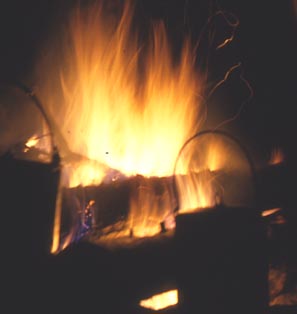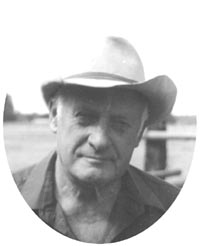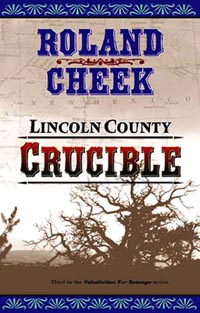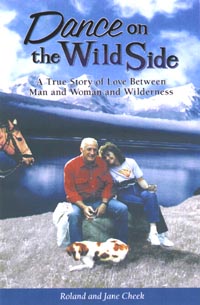a weblog sharing info on outdoor skills and campfire musing by a guy who spends a bunch of time in pursuit of both
CULTURE
WHERE -
TALES ARE TOLD OF
Welcome to Roland Cheek's Weblog
Roland is a gifted writer with a knack for clarifying reality. Looking forward to more of his wisdom
- Carl Hanner e-mail
General William Tecumseh Sherman no doubt had it right when he said: "I'm sick and tired of war. Its glory is all moonshine. It is only those who have never fired a shot nor heard the shrieks and groans of the wounded who cry aloud for blood, more vengeance, more desolation. War is hell!"
To access Roland's weblog and column archives
Tip o' the Day
Cooking baked potatoes in the campfire is easier if you pre-bake them about three-quarters done at home. Wrap in foil, then finish in campfire coals. The upside is that it won't take as long.
Take along some big plastic bags for camp garbage. Even if you use burlap oat sacks, the plastic bags will keep the throw-aways from oozing.
A good hot weather tip is to cover your ice chest with a sleeping bar or two during the day. No, no -- it's not to keep the chest warm, but to keep it cool -- provided you cover it early in the day, while ambient air temperature is still cool. And keep the chest in the shade.
Jane repackaged from jars to plastic as much as possible, or purchases foods already packaged in plastic. There are plastic canisters for peanut butter and squeeze bottles of good-tasting jams and jellies.
She packaged individual salads in Seal-A-Meal bags: three-bean, pasta, marinated corn.
And she pre-cooked roasts, hams, and sometimes chicken, packaged the meat in zip-lock bags and freezes it to ward off spoilage. All the above saves an unbelievable amount of weight for a float trip, or horseback packtrip.
Years ago we did it differently -- lots of jars and cans and fresh meat, whole potatoes, and store-bought pastries and cookies. Then she tried repackaging from jars and found she could eliminate 35 pounds of glass from one of our eight-person, ten-day hunting trips. By precooking much of the meats, she cut one-quarter of that weight and by packaging in zip-lock and freezing, there was no apparent loss in flavor.
While we were still guiding professionally, Jane baked all our wilderness trip cookies at home -- 320 dozen (3,840) homemade cookies for one season alone! All were baked and packaged for each individual trip, then stored in our freezer for timely use.
Desserts were tasty stir-and-serve pie fillings poured into already prepared cut-and-serve crusts. Or it was a stir-and-bake cake cooked in a Dutch oven.
In those days Jane's efficiency was readily apparent when she put together a hot, tasty, full-course meal ready for a troop of hungry guests, guides and their outfitter only an hour after pulling into some secluded and undeveloped campsite.
Echoes of Vengeance -- A military outpost situated in an isolated region of the Department of the Upper Missouri. An embittered Commandant who believes unkind fate kept him from fame and glory during the recent War of Seccession. A band of starving Blackfeet too riddled with smallpox to withdraw to their reservation. A young mixed-blood army interpreter whose aging parents are with the Blackfeet tries to prevent a massacre-in-the-making; he's beaten and dragged to the guardhouse for the attempt.
Thus the stage is set and principal characters in place for the opening pages of Echoes of Vengeance * Mule Milk News /Official Newsletter of the Montana Outfitters and Guides Association
WHAT FOOLS THESE MORTALS BE!
"What fools these mortals be!" Shakespeare's immortal line was the best I could do as I stood on the Gettysburg Battlefield, gazing across the mile and a half of open meadow where Lee sent General Pickett's division to near-certain death on the last day of the battle. I muttered the Bard of Avon's words in response to Bob's question, after a day spent on the battlefield, "Well what do you think?"
Bob was a former hunting guest who lives near York, Pennsylvania. While visiting the area, Bob and Brenda asked if Jane and I would care to visit Gettysburg. We leaped at the chance to go with a guy who dreams of retiring from his present sales job and becoming a tour guide on the battlefield.
We began by visiting sites north of Gettysburg, where the first day's battles took place. We followed the Union retreat through the town as they took up positions on Culp's Hill and Cemetery Hill, then strung out along a low ridge that culminated in the sharp mounds of Little Round Top and Round Top. Bob explained how Union General Daniel Sickles, against the will of his commanders, led his division beyond the forefront of the Union line to their destruction amid a peach orchard.
I'd heard and read of the violent struggle for the anchor point for the Union's left flank on Little Round Top. But my memory was only scanty about the struggle for the nightmare of boulders known as "Devil's Den." Actually standing in Devil's Den, and on Little Round Top, imagining the see-saw struggles taking place there; the screams of the dying, the eerie Rebel yells, the shouts and grunts of those engaged -- I'm afraid my brain was found wanting. Imagine blood filling shallow rifle pits? Soldiers (blue or gray -- it made no difference) with their entrails hanging out? I stood on the hallowed ground where Colonel Joshua Chamberlain rallied his 20th Maine to stand fast against wave after wave of Rebel gray. But was the carnage imaginable? Then the 20th Maine ran out of ammunition and Chamberlain ordered his troops to "Fix bayonets!" and led them in a charge downhill, against the startled, exhausted Alabamans who were clambering up to meet them.
Bob led me to Culp's Hill and Cemetery Hill where Lee ordered attacks on the Union right flank. Again the gray ranks were repulsed. At last we stood on the ridge where Robert E. Lee commanded General George Pickett to send his division into the emplaced guns of the Union center.
Both lines took positions along low ridges, with the Union line commanding the highest, along Cemetery Ridge. Between the two ridges spread a mile and a half of open farmland, dissected by two rail fences and the Emmitsburg Road. The 15,000 men of Pickett's Division eyed the far-off Union line, then began their attack. The "charge' was begun at a steady walk -- no one could run a mile and a half carrying field pack and rifle and still have anything left when they arrived to confront the enemy. It was a slaughter. Of Pickett's 15,000 men, only a handful actually broke into the midst of the men in blue. They were swiftly dispatched. There were but 5,000 survivors.
All in all, Lee lost 20,000 men at Gettysburg, the Union nearly as many. After viewing the battlefield, I'm afraid I lost all respect for the generalship of Robert E. Lee. He sent 10,000 men to their death in what by all odds was a foolish gamble that his worn and battered troops could once again rout a demoralized enemy. Was the man a victim of his own press clippings?
But that's not all; consider this if you will: Lee had already led his Army of Northern Virginia around the Union Army of the Potomac, who was mandated to stay between the Confederates and Washington. As a consequence, General George Meade led his Union forces in pursuit from the south. When the two armies collided at Gettysburg, the South attacked from the north, and the North defended the south. Translated, that means those gray-clad warriors were already into the fertile fields of the Union breadbasket, with their enemy behind them.
Yes, I understand that it's said Lee thought he must bring the Union army to battle and decisivly defeat them. Yes, I understand such a victory was deemed necessary to break the will of the North's people. If that objective was indeed the purpose of Lee wheeling to attack at Gettysburg it might make sense -- except for its urgency!
Throughout the Gettysburg battle, the Union always held the strategic advantage. Their line on Cemetery Ridge held every advantage: anchored on each flank by Culp's Hill and Cemetery Hill on their right, and Little Round Top on the left. Of far more importance, however, was that the entire Cemetery Ridge position was an artilleryman's defensive dream. With stone walls to protect the guns, and open fields to sweep with fire, the Gettysburg Battlefied turned into a textbook account of defensive artillery.
And that's what makes no sense.
Lee did NOT have to give battle at Gettysburg. He was ahead of his enemy. He could've continued to plunder northward until he could choose the ground for battle. He could've forced the Army of the Potomac to attack his own fixed positions. Instead, he apparently felt he could defeat any Northern army at any time, any place. And he led the South and 20,000 men to their destruction.
What fools these mortals be! I suppose the same appraisal could be made of any great battle -- even those won by "our" side. But read it however you will and you come to the same opinion still. We, collectively, are indeed fools. The choices are limited, of course. Would it require more courage to live through cowardice, than to march to one's death via bravery?
General Sherman no doubt had it right when he said: "War is hell." And its probable few generals throughout history have come to relish sending soldiers under their command to death and destruction--including Robert E. Lee. But they do. Sometimes, as with General Jonathan Wainwright and his embattled troops at Corregedor, their sacrifice had to be done to allow America to assemble forces, first for defense, then for offense against the Japanese. Sometimes, as in the battle for Stalingrad, an entire German army group of 850,000 men was sacrificed on the altar of Adolf Hitler's fantasy. War is not merely hell . . . it's lunacy!
Roland Cheek wrote a syndicated outdoors column (Wild Trails and Tall Tales) for 21 years. The column was carried in 17 daily and weekly newspapers in two states. In addition, he scripted and broadcast a daily radio show (Trails to Outdoor Adventure) that aired on 75 stations from the Atlantic seaboard to the Pacific Ocean. He's also written upwards of 200 magazine articles and 12 fiction and nonfiction books. For more on Roland, visit:
www.rolandcheek.com
Recent Weblogs
Tuesday, January 29, 2008h
There's a bunch of specific info about Roland's books, columns, archives and radio programs. By clicking on the button to the left, one can see Roland's synopsis of each book, read reviews, and even access the first chapter of each of his titles. With Roland's books, there's no reason to buy a "pig in a poke."
for detailed info about each of Roland's books
Read Reviews
Read their first chapters
For interested educators, this weblog is especially applicable for use in history, economic, and government classes, as well as for journalism students.
Roland, of course, visits schools. For more information on his program alternatives, go to:
NEXT WEEK:
SQUANDERING OUR LIFE'S BLOOD
www.campfireculture.com
Roundup Magazine says of The Silver Yoke, the final book in the acclaimed Valediction For Revenge series: This novel has lots of action, a terrific villain you love to hate, the smell of dust and dynamite, and a man sworn to bleed his enemies, not of blood but of money, the only they love.
This is another page turner from Cheek with characters that possess all three dimensions and are tough to kill. Any readers who likes action, adventure, and a plot with more twists than a sidewinder will love Gunnar's Mine * Roundup Magazine
Lincoln County, New Mexico, where poor farmers and ranchers are at the mercy of crooked merchants, the military, and a corrupt territorial government run by something called the "Sante Fe Ring," Bit who are the "good" guys? Billy the Kid? John Chisum?
Book three in the Valediction For Revenge series, the completion of Jethro Spring's adventures in New Mexico
Crisis On the Stinkingwater is Cheek's darkest book. It is also the most realistic. The portrayal of the depth of hatred engendered by the bitter conflict between rancher and homesteader chills the reader * Roundup Magazine
Two books -- one about the people, the second about their place of adventures
For detailed information about Roland's books
source links for additional info
to visit Roland's newspaper columns and weblog archives
to send this weblog to a friend
to tell Roland what you think of his Campfire Culture weblog
-










